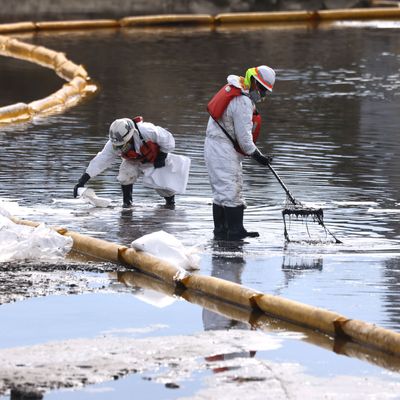
I’d imagine it was weird for them, and alarming, to wake up that morning to the smell of petroleum wafting inland from the Pacific Ocean. Alarming for the usual reasons — nobody gets happy when they smell flammable gas inside their home — but also weird in a way that felt unique to Newport Beach, the seaside getaway town in Orange County, 45 miles south of Los Angeles, that was recently named the wealthiest city in Southern California (the late NBA star Kobe Bryant owned a palatial home here) and one of the wealthiest in America. Bad things and bad smells from ecological disasters happen to plenty of people, but they’re not supposed to happen to people who live here.
Also weird, though, and almost as alarming, were the news descriptions of how local experts reacted to the pipeline rupture that belched up anywhere from 25,000 to 132,000 gallons of oil off the coast on October 1. Newport Beach’s harbormaster, Paul Blank, was “relieved the spill had been relatively contained,” according to the New York Times. “I live in fear of something like this happening.” Michael Ziccardi, director of the Oiled Wildlife Care Network, a consortium of trained care providers affiliated with UC Davis, told the Los Angeles Times that the number of oiled-coated birds they’d had to rescue as of Tuesday was “surprisingly low” — only one brown pelican had to be euthanized.
It’s normal, of course, to be glad a bad thing wasn’t worse, and so far, the death toll of this particular spill is low enough to keep it off the list of historically large mass marine die-offs, like those after the Deepwater Horizon disaster in 2010. But reading about what Ziccardi and his team are doing — dipping seabirds in tubs of detergent and lamenting how many sand crabs and their eggs are probably turning into poisoned snacks for the other local wildlife — you can’t help but feel we’ve warped our sense of “bad” to accommodate how bad things constantly are.
We don’t know all the details yet about last Friday’s spill, but we do know it’s not even the worst spill to affect this particular stretch of the Southern California coast since many of us have been alive. In 1990, a tanker dumped more than three times as much oil — 416,000 gallons — into the ocean off the coast of Huntington Beach, the city immediately north of Newport Beach. Longtime residents who remember 1990 have been compelled to adjust their frustration accordingly: You think this is bad? Try watching 3,400 dying birds wash onto the sand.
Accounts of the latest spill, though, read like a familiar study in negligence and ineptitude. According to the Associated Press, investigators are looking into the possibility that a passing cargo ship got its anchor caught on a 4,000-foot section of the pipeline 98 feet underwater, bending it about 105 feet out of place “like the string on a bow.” The unusual size of the gash that this supposed collision caused — about 13 inches, much smaller than for most spills that happen this way, which are characterized by gaping holes — may explain why investigators still aren’t sure it was caused by a massive anchor and why it took so long for the pipeline’s operator, the Houston-based company Amplify Energy, to know there was any leak at all. Locals reported seeing the beginnings of an oil slick on the surface of the water on Friday night, according to CNN. But it wasn’t until 2:30 a.m. on Saturday that a drop in pressure was detected by Amplify, suggesting that oil was getting out, and 6 a.m. before the pipeline got shut down. Martyn Willsher, Amplify’s CEO, told reporters the company didn’t know there was a spill until 8:09 a.m. As Saturday progressed and more and more of the story’s weird inconsistencies came to light, the slick kept spreading until it encompassed 13 square miles of ocean and invaded several local wetland preserves.
There will be plenty of blame laying and debate over who should be held accountable for the spill and even, it seems, about whether criminal charges are warranted. But we’re looking at a problem of mind-boggling scale and intractability. There’s a lot of pipeline in the water off the Pacific Coast: 200 miles in federally controlled waters alone, serving 23 different platforms, more than half of which are no longer producing oil or are in the early stages of being decommissioned. State-controlled waters are home to 1,200 active wells. Last year, California officials granted more permits to close existing wells than to open new ones, and Gavin Newsom has opened five since he became governor in 2019, even as he continues to push California toward some of the country’s most ambitious climate goals, like no more gas-powered cars by 2035 and no more oil production by 2045, according to the AP.
But much of the oil infrastructure that’s already out there is, at anywhere from 40 to 60 years of age, really old and really fragile — “time bombs waiting to go off” is how Miyoko Sakashita from the Center for Biological Diversity, an environmental-law group, described this decaying network of pipes and platforms to the New York Times. (The pipeline that spilled last week serves platforms that have been operating since the 1980s.) Not many stakeholders, if any, are interested in footing the bill for cleaning it up. It has been estimated that it will cost $800 million to decommission the wells in a single oil field off the coast near Long Beach, less than half of which has been set aside by the state. “It boils down to finances and priorities,” California assemblyman Patrick O’Donnell told the AP — a testament to the maxim that, if you want to make long-term money off a problem, make sure it’s so expensive that nobody will want to fix it.
And for a little more scale, the Gulf of Mexico is home to 8,600 miles of active pipeline, a figure that dwarfs that of the Pacific Coast. The crisis in Orange County is big. In the national scheme, it’s a drop in a barrel.






























